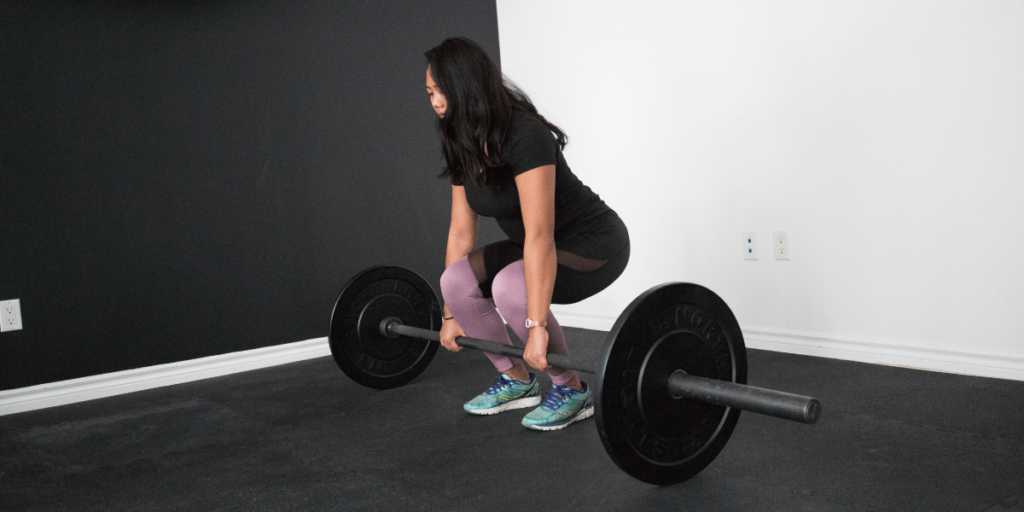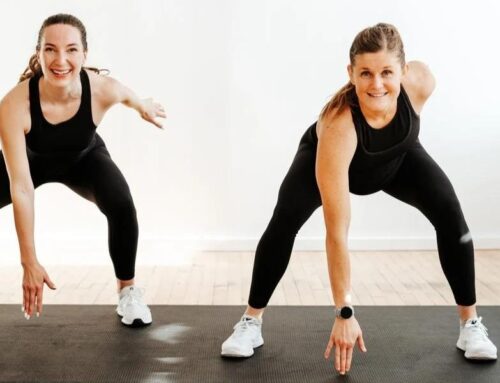
If you can’t or prefer not to deadlift, there are several exercises you can do to develop explosive strength and power. These alternatives build the proper foundation needed for maximum results in the big lifts like the squat and deadlift without sacrificing too much in terms of training economy. So if your back is giving you trouble or you just don’t want to deadlift all the time, check out these alternatives.
Before we get started, let’s first clear up a common misconception about the deadlift. It’s a great exercise, but there is a big difference between training for strength and power. Strength tends to be developed when you lower the weight slowly and then explode, which is the exact opposite of the deadlift’s concentric phase.
That’s not to say you can’t use the deadlift to develop explosive strength, but you might want to take a look at exercises like these instead.

What are the best Deadlift Alternatives?
Here are 10+ training movements that can be done to develop explosive strength and power, instead of the deadlift. I’ve included specific instructions on how to perform each movement along with some coaching tips so you can start using them in your own training.
1. Box Jumps.
Box jumps are one of the best exercises for developing lower body power. Their ease of setup, portability, and effectiveness has made them a mainstay in any athlete’s training routine. They can be used to increase vertical jump, improve speed and agility, and build power.
Box jumps develop explosiveness by stressing the muscles and connective tissues at near-maximal loads. They also require a good deal of coordination and mental focus which is why they’re particularly effective for training athletes. If you want to get the most out of them, use the following guidelines:
-Use a full range of motion when jumping onto the box. This means landing with your hips below parallel (when vertical) and extending at the hip, knee, and ankle (without locking out).
– Explode off the ground when jumping up to the box; do not approach it in a controlled fashion.
– Use a box that’s the appropriate height for your current training level (i.e., if you can jump onto it without any problem, you need to increase the difficulty).
If you’ve never done these before, start with an empty bar and add weight in 5 lb. increments until you reach a load that stimulates your fast-twitch fibers. You don’t have to use the barbell, you can use dumbbells or kettlebells instead.
How to do it:
- Standing in an athletic position with your feet hip-width apart, squat down and grasp both ends of a barbell in front of you using an overhand grip.
- Keep your arms fully extended and your back flat, then pull the bar off the ground and hold it with both hands in front of your hips.
- Assume a quarter-squat position and jump explosively onto the box.
- Land on the balls of your feet, keep your knees out and keep your chest up.
- Use the same motion to come down as you did going up.
- Focus on catching yourself with your hips low and open, not by leaning back.
Box height: Start with the box at mid-shin level or slightly below.
2. Power Cleans.
At first, this may seem like an odd choice to replace the deadlift with. After all, it looks like an Olympic lift and most think of those as being highly technical, hard to learn, and very taxing on the Central Nervous System (CNS). However, it’s actually a great deadlift alternative.
Its benefits include increased explosiveness through the increased leg and hip power due to the quickness with which they’re trained (i.e., you use heavier weights than if you were doing slow lifts), improved coordination due to learning proper lifting technique, and accessory muscle development that transfers over into bigger deadlifts down the road.
A properly performed power clean will keep your back flat throughout without any rounding or hitching at the top. Also known as a ‘high pull,’ this is one of two parts of the classic Olympic lift, the power clean and jerk.
It’s an extremely effective way to train explosiveness off the ground because it uses a weight that’s heavier than what you could do in the traditional deadlift (due to not having to set up at the top before pulling). If you’re looking for a ballistic movement that’ll develop your leg and hip power without taxing your CNS too much, try performing power cleans instead of deadlifts.
Power Clean Set-Up:
For set-up, stand over the bar with your feet under the bar. Grab the bar using an alternating grip (one hand pronated, one hand supinated), and make sure the bar is touching the front of your thighs.
Initiate the lift by shoving your hips forward, keeping your head up and chest out. This will help give you a “belly-up” position under the bar that’ll promote a quick turnover. Then, drop your hips and lift the bar in a vertical line by extending your knees and ankles simultaneously. Try to use the power generated from your hips and legs to “jump” the bar up. As you get stronger, you can experiment with different foot positions such as a split stance or even a wider than shoulder-width stance to see what feels best to you.
When the bar reaches the top position, it should end up around nipple level and the bar should be directly over your feet. The elbows must remain straight throughout the movement, but it’s okay if they bend slightly. After the bar passes your knees, aggressively pull under and slightly back to catch the bar in a front squat position and stand up tall.
3. Stone/Sandbag Loading.
For those that train alone or don’t have access to a deadlift platform, something as simple as loading up a heavy sandbag or stone can be a great alternative.
I’ll typically set the implement on the floor, stand over it with feet shoulder-width apart, bend down and grab it with an over-under grip (one hand facing towards me, one away), then stand up while keeping my back flat and hips higher than shoulder-width apart.
Once I’m standing, I’ll take 2-3 steps back while keeping my heels flat on the floor and set my feet at shoulder width again. Then, I … explode! 💥 😉
4. RDL’s (Romanian Deadlifts).
If you’re coaching a beginner, it’s most likely they’ve never done Romanian deadlifts before.
The RDL is basically the same movement as a deadlift, but it eliminates the hip hinge. If someone is new to strength training, they’re most likely not strong enough for conventional deadlifts.
That’s why the RDL is a great alternative because it eliminates all of that hip hinge, setup, and wiggling that occurs before the deadlift.
5. Rack Pulls.
Rack pulls are a great deadlift alternative that’ll allow you to overload the movement and work on your lockout strength from a deficit.
I’ll set the pins in a rack so that when standing with the bar at my feet there’s just enough space to squeeze through and grab it. Then, I stand over the bar with feet shoulder-width apart and grip it as if I were performing a normal deadlift (over-under grip or just outside hip width).
I’ll keep my core tight, chest up, eyes forward, back flat and hips higher than shoulder-width apart to prevent rounding. I’ll take a deep breath into my belly then explosively pull the bar off the pins by pulling with my legs while keeping my arms straight until I’m standing fully upright at the top of the movement with shoulders roughly 15° above parallel.
6. Off a 4″ Box.
I’m not going to get into the merits of this exercise, but all you need to know is that it’s a great deadlift alternative for those that have trouble with their back rounding as they pull from the floor (i.e., most people). It can also be useful if you don’t want to overload the movement with more weight.
I’ll set the bar on a small platform (4″) then walk up closer to it so that my shins are almost grazing it. I’ll keep my core tight, chest up, eyes forward, back flat and hips higher than shoulder-width apart to prevent rounding. I’ll take a deep breath into my belly and explosively pull the bar off the platform by pulling with my legs while keeping my arms straight until I’m standing fully upright at the top of the movement with shoulders roughly 15° above parallel.
7. Deficit Pulls (2-3″).
Deficit pulls are another great deadlift alternative that’ll allow you to overload the movement and work on your lockout strength from a deficit.
I’ll set the pins in a rack so that when standing with the bar at my feet it’s just high enough to have to pull from a 2-3″ deficit while shins nearly graze the bar. I’ll keep my core tight, chest up, eyes forward, back flat and hips higher than shoulder-width apart to prevent rounding. I’ll take a deep breath into my belly then explosively pull the bar off the pins by pulling with my legs while keeping my arms straight until I’m standing fully upright at the top of the movement with shoulders roughly 15° above parallel.
8. Rows.
I’m not going to get into the merits of this exercise, but all you need to know is that it’s a great back-builder and deadlift alternative for those at any level of experience. It can also be useful if you don’t want to overload the movement with more weight.
I’ll grab a barbell with an over-under grip (one hand facing towards me, one away) and let it hang at arm’s length in front of my body. Then I’ll bend over so that my back is nearly parallel to the floor – I’ll pull the bar down until it reaches my upper abs then explosively pull it upwards until I’m standing straight again while bringing my shoulder blades together at the top of the movement.
9. Band Deadlifts.
Band deadlifts are a great alternative to regular deadlifts. I like them because they’re easy on the back and still allow you to lift heavy loads. Plus, they can be used as part of a finisher or even be pre-exhausted prior to training (e.g., band-resisted deadlifts prior to regular deadlifts) and both options will fry your back and legs.
I’ll stand on a mini-band, shoulder-width apart with my toes pointing straight ahead or slightly outwards (if I’m looking for more glute/hamstring involvement). I’ll then step away from the band enough so that it provides light tension – you don’t have to step too far away, just maybe a foot or two.
I’ll grab the bar with an over-under grip (one hand facing towards me, one away) and let it hang at arm’s length in front of my body. Then I’ll bend over so that my back is nearly parallel to the floor – I’ll pull the bar down until it reaches my upper abs then explosively pull it upwards until I’m standing straight again while bringing my shoulder blades together at the top of the movement.
10. Band-Resisted (or Resisted) Good Mornings.
Band resisted good mornings are a great alternative to regular good mornings. I like them because they allow you to lift heavy loads while minimizing stress on the lower back and hips due to the resistance coming from a band. It can also be useful if you don’t want to overload the movement with too much weight or simply need variety in your training.
If you’re using a mini-band around your knees just loop it around your legs. However, if you’re using a full-size band I find it more comfortable to have someone hold the other end or wrap it around a power rack.
I’ll grab the bar with an over-under grip (one hand facing towards me, one away) and let it hang at arm’s length in front of my body. Then I’ll bend over so that my back is nearly parallel to the floor – I’ll pull the bar down until it reaches my upper abs then explosively pull it upwards until I’m standing straight again while bringing my shoulder blades together at the top of the movement.
11. Dumbbell Rows.
Dumbbell rows are a great back-builder as well as a deadlift alternative. You can do them standing or on your knees. I like them because they allow you to lift heavier loads than the aforementioned exercises without compressing your spine (from performing barbell rows).
I’ll grab a pair of dumbbells with an over-under grip (one hand facing towards me, one away) and let it hang at arm’s length in front of my body. Then I’ll bend over so that my back is nearly parallel to the floor – I’ll pull the dumbbells up to my side then explosively pull them towards my chest while bringing my shoulder blades together at the top of the movement.
Deadlift Alternatives – Takeaway
There are many deadlift alternatives that can be used in place of regular deadlifts or to complement them. I’ve listed ten different variations above that can allow you to lift heavier loads, minimize stress on the back and hips, or even be used as part of a finisher.
Give them a try and let me know if they’ve helped you break a plateau or shave some time off of your deadlift.



